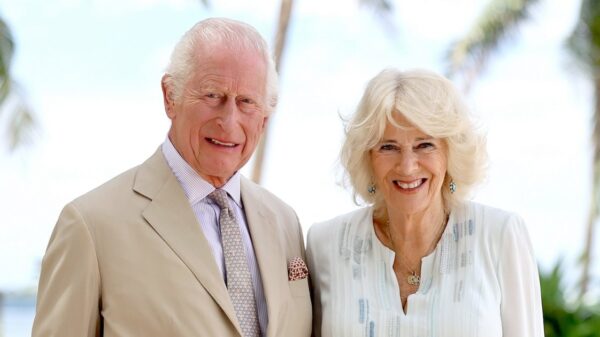Fleetwood Mac‘s groundbreaking 1977 album Rumours celebrates the 48th anniversary of its historic release on February 4.
The record stands as a testament to the power of band camaraderie as it was recorded during a period of intense turmoil for Fleetwood Mac. The group’s two couples – Stevie Nicks and Lindsey Buckingham, as well as Christine and John McVie – split prior to Fleetwood Mac arriving at the Record Plant in Sausalito, California to create their 11th studio album, while drummer Mick Fleetwood‘s own marriage was crumbling. Fleetwood Mac channeled heartbreak, anger and drug-fuelled madness into the creation of one of rock music’s landmark albums.
“We were all writing songs about each other basically, although we were unaware of it at the time,” Christine McVie said in the documentary Classic Albums: Fleetwood Mac – Rumours. “All of the songs were about our own private relationships and our troubled relationships. I think it was John who suggested the name Rumours because we were writing, sort of, journals and diaries about one another.”
Rumours won the Album of the Year Award at the Grammys in 1978 and eventually sold 40 million records. As this classic album reaches a milestone birthday, keep scrolling to find out the deeply personal stories behind every track on Rumours (and even one bonus selection!).
“Second Hand News”
Buckingham revealed in the Classic Albums documentary that “Second Hand News” was always a contender to be the opening track on Rumours.
The jaunty opener blends Scottish and Irish folk songs with a jangly disco sheen at least partially inspired by The Bee Gees’ 1975 hit “Jive Talkin’.”
“When we first started cutting [the song], I think we were doing it as something that was a more literal translation [of Scottish and Irish folk],” Buckingham remembered. “We were also very interested in keeping the pop elements since it was going to be the first song and it was going to be a pop album.”
Fleetwood Mac ultimately decided to integrate “a dance beat within the confines” of the folk influence in order to kick off Rumours with a bang, according to Buckingham.
“Dreams”
One of Stevie Nicks’ signature songs came about when she snuck away from the main studio in the Record Plant to visit an empty hall once used by Sly Stone, of Sly and the Family Stone.
“I knew when I wrote [“Dreams”] that it was really really special,” Nicks said in Classic Albums.
Nicks was confident enough in the song to bring it to the rest of Fleetwood Mac right away, though she worried about how the others might change her vision.
“It’s always difficult to give your song to somebody and know that they’re going to take it places you can’t take it because they play guitar and piano and arrange music,” she admitted. “If they do a good job, then it’s great. If they don’t then it’s not great… Lindsey had an amazing way of taking my songs and making them wonderful when he was happy with me.”
Related: Fleetwood Mac’s Christine McVie Admitted to Feeling Jealous of Stevie Nicks
Fleetwood Mac’s lineup shifted several times over the years, but when Stevie Nicks and Lindsey Buckingham joined the group, everything changed. In a new book titled Songbird: An Intimate Biography of Christine McVie, published Tuesday, November 19, writer Lesley-Ann Jones describes the first time Nicks, now 76, and Buckingham, now 75, were introduced to existing […]
Buckingham spoke of the push-and-pull of his creative partnership with Nicks, admitting that there were times he wasn’t motivated to help achieve her vision.
“Whatever Stevie’s music was, somehow I was this soulmate who just knew exactly what to do with it,” Buckingham acknowledged. “That never went away. It just became a little bittersweet.”
“Dreams” topped the Billboard charts in June 1977 and would become one of Fleetwood Mac’s most recognizable songs. The track reached a whole new generation following the viral success of Nathan Apodaca’s skateboard video, which used “Dreams” as a backing track, in 2020.
“Never Going Back Again”
Buckingham’s mournful ballad was completed “near the end” of Rumours‘ recording process, as the guitarist realized there was no way to repair the romantic part of his relationship with Nicks.
“I had met [another] young lady,” he revealed in Classic Albums. “It didn’t turn into anything heavy but what it did do was put a little wind in my sails in terms of… having a regenerative spirit about things and being able to move on, which I hadn’t really been able to do for a little while.”
“Never Going Back Again” became a staple of Buckingham’s solo sets throughout his career, as well as a poignant concert moment for Fleetwood Mac during their reunion tours.
“Don’t Stop”
This Christine McVie-written track became another of Fleetwood Mac’s signature songs, as well as U.S. president Bill Clinton’s campaign theme during his 1992 election bid.
Originally called “Yesterday’s Gone,” Christine ultimately went with a more hopeful title to express her optimism for the future despite her recent split from bandmate John McVie. It wasn’t until decades later that John realized that “Don’t Stop” was written about the demise of his marriage.
“I never put that together. I’ve been playing it for years and it wasn’t until somebody told me, ‘Chris wrote that about you.’ Oh really?” John confessed in a 2015 interview.
“Don’t Stop” holds such a special place in the Fleetwood Mac canon that Buckingham and Christine dared not play it when they headlined a special tour without the rest of the band in 2017.
“Go Your Own Way”
Buckingham has said that he wrote Rumours‘ hardest-rocking track as a way to cope with the “rather unusual situation” within Fleetwood Mac’s creative dynamic.
While “Never Going Back Again” was a gentle reflection on a failed relationship, “Go Your Own Way” blazed with defiance and anger in the aftermath of a traumatic breakup.
“You had two couples breaking up in the process of making this album so you had all this cross-dialogue going on,” Buckingham noted in a 1993 interview.
Buckingham confirmed that “Go Your Own Way” was “basically directed at Stevie,” while Fleetwood described the song as “Stevie and Lindsey playing out whatever roles they were playing out.”
“I mean, some heavy stuff went on with that song,” Fleetwood said with a laugh.
Related: Band Members Who Have Dated Each Other: Paramore, Fleetwood Mac and More
MFleetwood Mac is perhaps the most famous example of bandmates dating each other — and the ensuing complications that come with it. Thank You! You have successfully subscribed. Subscribe to newsletters Please enter a valid email. Subscribe By signing up, I agree to the Terms and Privacy Policy and to receive emails from Us Weekly […]
Nicks described “Go Your Own Way” as Buckingham’s answer to her own song “Dreams,” adding: “‘Dreams’ was hopeful… unlike ‘Go Your Own Way,’ which was not hopeful that we would be OK.”
“Go Your Own Way” became the first of Fleetwood Mac’s successful singles from Rumours when it reached the Billboard Top 10 in March 1977.
“Songbird”
Christine McVie likened the writing process of the austere and beautiful “Songbird” to a “spiritual” experience.
“That was a strange little baby, that one,” she told The Guardian in 2016. “I woke up in the middle of the night and the song just came into my head. I got out of bed, played it on the little piano I have in my room, and sang it with no tape recorder. I sang it from beginning to end: everything. I can’t tell you quite how I felt; it was as if I’d been visited – it was a very spiritual thing.”
McVie was hesitant about bringing “Songbird” into the Rumours recording sessions at first because she worried she wouldn’t be able to recapture the magic of her first time playing it.
“I was frightened to play it again in case I’d forgotten it. I called a producer first thing the next day and said, ‘I’ve got to put this song down right now,’” she recollected. “I played it nervously, but I remembered it. Everyone just sat there and stared at me… I’ve never had that happen to me since. Just the one visitation. It’s weird.”
Rumours producer and engineer Ken Caillat told fans at a Grammys Q&A in 2014 that he knew “Songbird” was “amazing” the first time he heard it.
“We were finishing up one of the crazy sessions [at] Sausalito Record Plant and I was wrapping up some [studio] cables,” he said. “Christine sat down at the piano and started playing this beautiful song. I stopped what I was doing and I turned around and watched her. I was just amazed at how beautiful this song was.”
“The Chain”
All of the angst bubbling up around Fleetwood Mac boiled over in the opening drum beats of “The Chain,” which spoke to the healing power of band camaraderie despite any inter-personal issues they had.
“It just all came out in the studio when we were recording. A lot of the emotion of those moments like that solo are very connected to what we were living,” Buckingham told Entertainment Weekly in 2021. “The thing about ‘The Chain’ is, yes, it’s a signature piece of ours, but it’s also the spirit of the song and the content lyrically is very much in keeping with the legacy we built over a long period of time of always being able to rise above the difficulties in order to fulfill a greater destiny, so there was always a chain.”
“The Chain” was picked as the opening song for Fleetwood Mac’s 1997 reunion concert The Dance due to the theme of unity in its lyrics.
“You Make Loving Fun”
While Buckingham and Nicks’ breakup was playing out in full view of the Rumours recording sessions, Christine McVie was trying to keep her relationship with Fleetwood Mac’s lighting director, Curry Grant, a secret from ex-husband John.
Legend has it that Christine initially told the other members of Fleetwood Mac that “You Make Loving Fun” was actually written about her dog, yet she eventually shared the truth in the Classic Albums documentary.
“That [song] was about my then-boyfriend, at the time,” McVie confirmed. “For obvious reasons, since he was our lighting director, he was not welcome in the studio.”
Producer Richard Dashut pointed out in the doc that “You Make Loving Fun” was “almost done” in Christine’s head before she ever started recording it.
Related: Stevie Nicks: How Taylor Swift Helped Me Grieve Christine McVie’s Death
The songbird is still singing. Stevie Nicks opened up about how she’s been coping after Christine McVie’s death — and gave Taylor Swift a shout-out in the process. The 74-year-old Fleetwood Mac singer performed at Atlanta’s State Farm Arena on Monday, May 22, pausing briefly during the concert to thank Swift, 32, for one powerful […]
Buckingham felt that “You Make Loving Fun” was proof that he shared a “common foundation” with Christine even though they’d come from very different musical backgrounds.
“Even though she was trained [in music] and I was not, and even though her background was in the blues, we had a very similar melodic sense in many ways so that we could jam on guitar and piano and it would just spark off,” Buckingham insisted.
“You Make Loving Fun” hit No. 9 on the Billboard chart when it was released as the fourth and final single from Rumours in September 1977.
“I Don’t Want to Know”
“I Don’t Want to Know” holds a contentious place in the Rumours tracklist because it replaced eventual B-side “Silver Springs” on the album despite Nicks’ objections.
Nicks remembered in a BBC documentary that Fleetwood delivered the news that the rest of Fleetwood Mac felt “Silver Springs” wouldn’t vibe with Rumours‘ other songs.
“[I was told] there’s a lot of reasons, but because basically it’s just too long. And we think that there’s another of your songs that’s better, so that’s what we want to do,” Nicks recalled. “Before I started to get upset about ‘Silver Springs,’ I said, ‘What other song?’ And he said, ‘A song called ‘I Don’t Want To Know.’ And I said, ‘But I don’t want that song on this record.’ And he said, ‘Well, then don’t sing it.’”
“I Don’t Want to Know” pre-dated its inclusion on Rumours, since Buckingham and Nicks originally recorded the track first for their 1973 studio album. Fleetwood Mac fleshed out the song’s country music influences with a vibrant blast of McVie’s Wurlitzer electric piano.
“Oh Daddy”
At the time of Rumours‘ release, Christine gave a series of interviews where she said “Oh Daddy” was inspired by bandmate Mick Fleetwood’s then-recent separation from his wife Jenny Boyd.
Producer Ken Caillat wrote in Making Rumours: The Inside Story of the Classic Fleetwood Mac Album that Mick Fleetwood considered “Oh Daddy” to be a “lesson in less is more.”
“It’s one of my favorite songs that Christine has ever written,” Fleetwood said. “I think it’s a fantastic song.”
“Oh Daddy” was revived in Fleetwood Mac’s live set on their 1997 reunion tour but was retired from concert performances in the band’s later years.
“Gold Dust Woman”
Rumours‘ closing tracking remains one of Nicks’ most haunting compositions with its allusions to cocaine use and the heartbreak she was facing at the time of recording.
“[“Gold Dust Woman”] was really my kind of symbolic look at somebody going through a bad relationship and doing a lot of drugs and trying to just make it, trying to live, trying to get through it to the next thing,” Nicks acknowledged in the Classic Albums doc.
Buckingham credited “Gold Dust Woman” with giving Fleetwood Mac a chance to “get a little looser, a little more abstract” in their recording process.
“The song is very dark, it’s quite loose and somewhat acrimonious,” Buckingham continued. “I’m guessing that the acrimony was directed at me at the time.”
The title of “Gold Dust Woman” comes from the real Gold Dust Lane in Wickenburg, Arizona, where Nicks spent considerable time as she was growing up.
“Silver Springs”
Bonus track! Rumours‘ great lost song was scrapped from the album at the last minute, when Fleetwood Mac felt that “I Don’t Want to Know” would be a better fit with the rest of the tracklist.
Nicks recalled in a 1993 BBC documentary how reluctant she was to let go of “Silver Springs”, which she regarded as the best song she’d ever written at the time.
“I started to scream bloody murder [when they told me] and probably said every horribly mean thing that you could possibly say to another human being, and walked back in the studio completely flipped out,” Nicks acknowledged. “I said, ‘Well, I’m not gonna sing ‘I Don’t Want To Know.’ I am one-fifth of this band.’ And they said, ”You can either (A) take a hike or (B) you better go out there and sing ‘I Don’t Want To Know’ or you’re only gonna have two songs on the record.’ And so, basically, with a gun to my head, I went out and sang ‘I Don’t Want To Know.’ And they put “Silver Springs” on the back of ‘Go Your Own Way’ [as a B-side].”
Nicks had the last laugh by reviving “Silver Springs” for a show-stopping performance in Fleetwood Mac’s 1997 reunion concert The Dance.
Read the full article here










































